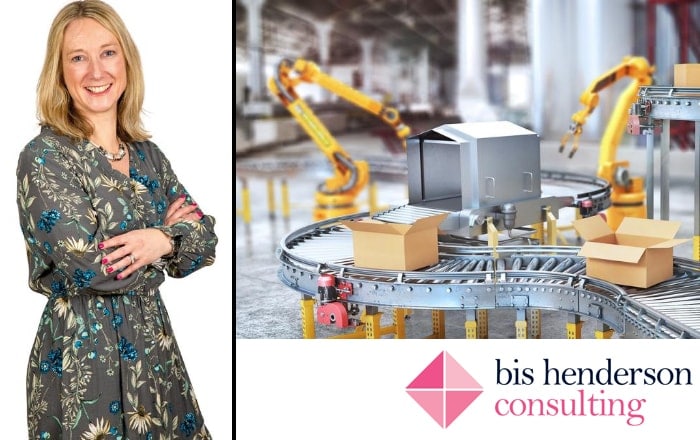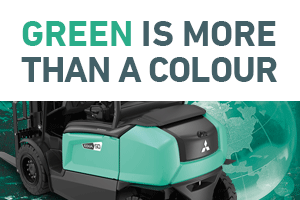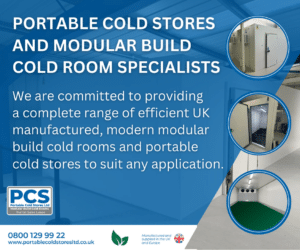By Louisa Hosegood, Digital and Strategy Director at Bis Henderson Consulting
Retail warehousing operations have performed heroically during the pandemic crisis, and we have seen, and helped, our clients find swift, creative and sometimes rather brave solutions to the issues that COVID 19 has raised. Our recent White Paper on the sector’s response to COVID provoked some key thoughts for supply chain in the next normal: one of these is the need for much greater levels of appropriate automation.
That is easy to say, but ‘automation’ can range from a simple conveyor system to cutting edge Artificial Intelligence. Here we offer a five-step process that will help your business find the appropriate levels and applications of automation for your business, now and into the future.
The retailers that have survived, and will prosper, undoubtedly are those with supply, fulfilment and return networks that are flexible, agile and responsive – capable of adapting quickly to changing business environments and consumer lifestyles, thinking and demands. Critically, such supply chains will not just respond to the imperatives of the moment but be able to transform to support the future productivity, sustainability and profitability of the business.
With social distancing, the traditional solution of throwing more labour at problems has broken down. Even before COVID it was likely that labour might no longer be ‘cheap’, nor available, while the need to improve productivity is pressing. Meanwhile the shift to eCommerce is making warehouse operations more complex and more time-critical, but at the same time ‘bricks’n’mortar’ retailing still needs to be supported and rejuvenated. All this with an eye on sustainability, resilience and future-proofing in an increasingly unpredictable world.
Automation, both of physical operations and of underlying business processes, must form part of the answer. Some companies are already well down the automation road. Others are hastily re-evaluating their needs and bringing forward their investment. For many, though, the prospect of automation is scary – inflexible, high risk, disruptive, unaffordable – and altogether outside their comfort zone.
But think again. Any warehousing operation can achieve appropriate levels of automation that are scaleable, affordable, flexible and that will generate and lasting returns. Every business’ route map and destination will be different, but by following a five-point approach to planning and decision-making, companies can advance through the automation jungle swiftly and with confidence.
1. Understand your external environment
Change is the only constant. However, there are discernible trends that firms need to be ahead of. The growth in eCommerce is but one. Geopolitics and other factors may radically change the sources and holdings of goods, for example, through near-shoring. The rise of the ‘conscious consumer’ means that ethical, environmental and other considerations now rank with price and availability, so not just goods, but warehousing, transport and other supply chain operations, will need to demonstrate compliance to green and ethical standards. Meanwhile, other businesses are competing not just for your customers, but also for your labour, transport, space and other resources.
How do these issues affect the demands you place on your warehouse operations in terms of speed of response, service levels, service differentiation, choice (not just of goods but of delivery modes and locations), late order cut-offs, order collation, and returns policies? How do your customers value these: are they prepared to pay, are they expected as standard, where do their ethical allegiances lie versus their desire for value and convenience? Automation solutions can solve many of these, but it’s about prioritising those business ambitions that the supply chain can deliver.
2. Analyse how your business works
Automation is not about adding tech for tech’s sake: it’s about investing in the right solutions that match your business now while offering flexibility for the future. The key to this lies in understanding your own business and its supply chain characteristics, for example: product rate of sale, physical product dimensions, daily or weekly work profile, returns rates, the services you offer, and how these factors vary.
It’s important to think not only about current warehouse operations, but also how these should develop to support longer-term business ambitions, be those shorter customer lead times, wider product range, or alternative delivery points, ensuring that these are envisaged in any automation specification.
Most companies know less than they think about how their warehousing and fulfilment actually works. There are the unofficial work-arounds, the informal stock locations, the ‘on the fly’ decisions. Often, warehouse operations and layouts have evolved, rather than having been planned.
Responses to eCommerce are a good example, though not the only one. At only a few percent of sales it has been possible to pick, pack and dispatch individual online orders reasonably easily in a largely case and pallet environment. However, as eCommerce now approaches 30% in some retail sectors, that approach is no longer tenable for most. Appropriate automation can help resolve these sorts of conflicts.
Importantly, there is absolutely no point in automating a set of processes that are inherently inefficient. Social distancing has revealed some of the inefficiencies: any area where distancing has been difficult because labour has been thrown together – for example at packing stations, or particular pick faces – is probably running ‘hot’ and is ripe for automation.
Other inefficiencies may be less obvious. How long after a delivery is received do goods become available for picking? How much time do employees spend queuing at a printer to receive their next job sheet or pick list? These may suggest automation solutions to processes rather than materials handling. By identifying the bottleneck processes, it may be possible to reorganise or reconfigure some parts of the operation so that automation is not needed everywhere or immediately and can be prioritised on those areas that will really deliver early benefit. And remember that robots are for life, not just for Christmas. Short-term problems need to be addressed first, before investment in automation as part of the longer-term strategy. It’s not about where you are, it’s about where you are going.
3. Matching solutions and providers
There is a very wide range of solutions, from simple conveyors to Autonomous Mobile Robots (AMRs), shuttles, carousels and other automated storage/retrieval systems, picking robots, automated packing solutions, and container de-stuffing systems. Then there are ancillaries to support human or automated operations, from RFID and scanning to voice directed picking, and WMS and other IT.
Selection is about assessing the pros and cons of different solution types and what would suit your business, products and physical environment, as well as your budget and time expectations.
Flexibility is key, so it’s not necessarily about automating everything – automation can be a constraint if it can’t easily change or adapt to a new circumstance or requirement. The best way forward may be to combine manual, mechanised and automated processes, choosing the right things to mechanise and automate depending on your business and your customer requirements. It’s about automating those areas and processes, where the investment will genuinely solve problems and deliver benefits, so a degree of skepticism is in order.
Most systems will have a variety of features, some of which are more or less important to your own operation and products. Finding this match is an important part of the selection process. Systems interfaces should not be a barrier as most should be capable of interfacing with other vendors’ products and with a wide variety of control systems or WMS without much trouble.
There are providers who are only really interested in major corporate business and there are others who specialise in the needs of SMEs. But remember, just because your company is small does not mean that the particular task isn’t intense or complex, requiring something more sophisticated.
Consider training, maintenance and support: who will do this and what are the ongoing cost commitments and service levels? Not all vendors offer a full service long-term; but then not all automation requires this.
It really is vital to create, and adhere to, a formal process to guide you through this jungle. The clarity that comes from creating the business requirements documentation and functional design specification is not only key to selecting the best automation solution, it’s also central to the procurement process as it creates the assessment criteria list. It also forms the basis of the commercial contract and critical decisions such as buy versus lease. Time really must be committed to this upfront design phase.
Shortlisting and selecting solutions and vendors, assessing their capabilities, matching these to requirements and assessing value for money can be a mind-boggling exercise but it has to be got right. This is certainly an area where it can be worth hiring in some vendor-neutral expertise.
4. Making the business case
Tangible benefits may include increased productivity, reduced costs (not necessarily just labour), improved stock accuracy, improved pick accuracy, better space and asset utilisation, improved customer service levels, and better data visibility, which can feed improvement right across the business.
The case should also demonstrate scalability, future proofing, support for supply chain resilience, and perhaps contributions to environmental, employee welfare and other goals. The impact on labour market resilience – attracting, retaining, protecting, and enhancing the experience of the workforce, is also important.
Costs will depend on the solution itself – a modular design and implementation approach could smooth cash outflow and link more closely to business volume growth. Increasingly some automation, such as mobile robotics and many of the IT elements, is available to lease or as ‘aaS’ (as a Service), giving alternative and lower-risk financing options. Service Level Agreements, for maintenance, upgrades etc., need to be carefully considered and there also may be a requirement for in-house IT, maintenance and other specialist skills. Depending on the solution, there may be other costs such as building-related expenditure – flooring, wiring, internal reconfiguration.
Return on investment speed will also depend on the solution chosen and the current operation. Some automation is designed to be a long-term strategic investment, while other plans may be about quick wins and low-hanging fruit (although longer-term goals still need to be included). It’s about ensuring the right match between your business and the solutions available, now and for the future.
5. Successful implementation
While installing most automation is no longer the ‘shut the site for six months’ project it used to be, implementation still requires careful planning and appropriate resourcing.
Successful implementations include bringing end-users into the project at the beginning, as much to achieve cultural change and user acceptance as to ensure robust operational input. There should be a process in hand for post-implementation continuous improvement, of the automation itself and of the ways in which the business interacts with the automation.
Comprehensive programme management will include planning for go-live, for user acceptance testing, and for maintaining current operations at an acceptable level throughout the process. Technical expertise may come from the vendor, and perhaps an independent consultant/systems integrator, especially if a multi-vendor installation is proposed.
Conclusion
The detailed route map that evolves from these five steps will be unique to each organisation. But following these steps should help maximise the benefits of automation, while minimising costs and the possibility of nasty surprises.
Does any of this resonate with you and your business direction? Are you considering warehouse automation? Are you already in the middle of an automation change process but it’s not progressing along the path you thought or expected?
With a wealth of automation experience across many sectors, Bis Henderson Consulting can help guide your company through its review of the new retail landscape, analysis of current operations, and assessment of the potential for automation – as well as offering vendor-neutral advice in supplier and solution selection, through to detailed design, project implementation and post go-live independent review and enhancement. Success depends upon expertise.
More on Bis Henderson Consulting at www.bis-hendersonconsulting.com











